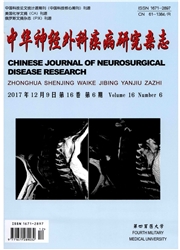

 中文摘要:
中文摘要:
目的建立一种稳定可靠的可降低侧支循环影响的大鼠全脑缺血模型操作方法。方法实验用SD大鼠50只随机分为3组:假手术组;缺血15min组;缺血25min组,在麻醉状态下仰卧固定,打开胸廓上口,分离并夹闭双侧锁骨下动脉起始段;后两组动物待接近清醒时分别夹闭其双侧颈总动脉15min和25min后松开动脉夹实行再灌注。各组动物分别于手术后24h、48h、72h和7d进行神经功能测试,并于最后一次测试后立即灌注固定组织,取脑组织进行组织学观察,统计海马、皮层等区域神经细胞的状态进行比较,以海马CA1区大部分神经元细胞出现死亡为模型成功标准。结果与假手术组相比,15min组和25min组之存活动物均显示出明显的神经功能降低,其组织学观察结果亦非常稳定,剔除因抽搐死亡的动物后模型成功率可达到100%(试验中未观察到存活动物模型失败的情况)。其中,25min组的动物死亡率高于15min组,并可观察到较15min组更加广泛的神经元坏死。结论本改良四血管阻塞法大鼠全脑缺血模型可明显提高模型制作的可靠性和成功率。
 英文摘要:
英文摘要:
Objective To establish a new method of 4-vessel occlusion (4VO) rat model which is able to decrease the effect of collateral circulation. Methods The common carotid arteries and the beginning of the subclavian arteries of rats were occluded for different period. Neurological deficits scores were recorded by the modified Garcia scoring system and histopathological methods were used to test the effect of model up to 7 days after the reperfusion. Results The neurological scores in 15 rain group and 25 rain group decreased significantly at 24 h, 48 h and 72 h after reperfusion (P 〈0.05), and the histopathological study showed that there were stable and symmetrical changes of lesions in all the ischemia samples of bilateral hippocampus in two ischemia groups, compared with that of sham-operated group (P 〈 0. 05). Conclusion It is demonstrated that the new method can improve obviously the reliability and success rate of 4VO rat model.
 同期刊论文项目
同期刊论文项目
 同项目期刊论文
同项目期刊论文
 期刊信息
期刊信息
